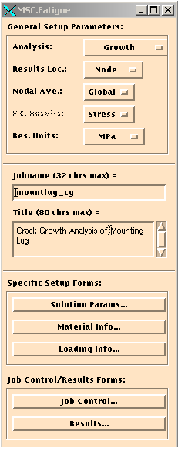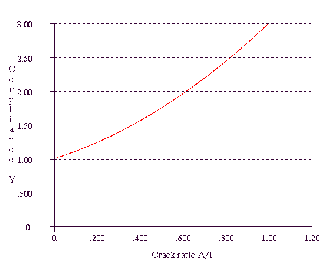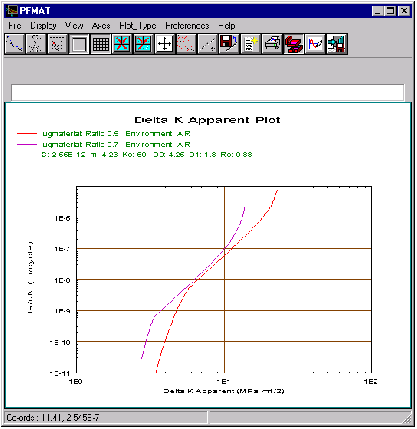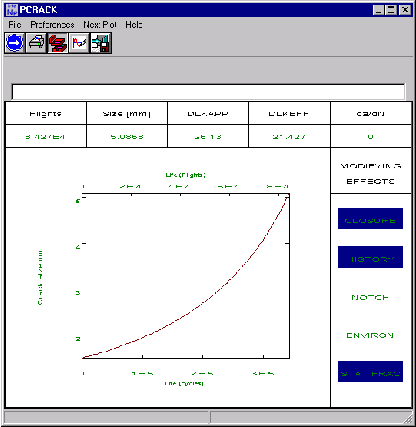XXXXXXXXXXXXXXXXXXXXXXXXXXXXXXXXXXXXXXXXXXXXXXXXXXXXXXXXXXXXXXXXXXXXXXXXXXXXXXXXXXXXXXXXXXXXXXXXXXXXXXXXXXXXXXXXXXXXXXXXXXXXXXXXXXXXXXXXXXXXXXXXXXXXXXXX''"> Crack Growth Analysis of Engine Lug
The Total Life calculation we have just carried out is for a defect-free component. Because this is such a safety-critical component, we should not assume that it is defect-free. The part can be inspected for cracks, and the method used to inspect it is capable of detecting cracks of 1.5 mm or more in depth. If inspection reveals no cracks, we should assume the worst case which is that there is a crack of 1.5 mm at the most highly stressed location, i.e., Node 1120. We then want to know what will happen to this crack in service. Will it grow? And if so, how long will it take to cause failure?
It is assumed that the database is still open and the MSC Fatigue main form is open. Set up the Crack Growth analysis now by setting the General Setup Parameters as follows:
1. Analysis: Growth
2. Results Loc.: Node
3. Nodal Ave.: Global
4. F.E. Results: Stress
5. Res. Units: MPa
6. Jobname: mountinglug_cg
7. Title: Crack Growth Analysis of Mounting Lug
Solution Parameters
Copy the file lug.ksn to your working directory.
Open the Solution Params... form. A compliance function for the specimen has been created to define the crack geometry. It was empirically derived via specimen tests and curve fit to a polynomial function. It was in this form, using PKSOL, that it was input (by defining the coefficients of User parametric definition).
The compliance shows roughly what the crack growth rate will be. In this particular example the crack growth rate will increase as the crack gets larger relative to the width of the lug. The compliance function is used to derive the driving force (ΔK) of the crack as formulated in the Paris Law, using the equation

. T is a model dimension, in this case the width of the lug at the critical location, 24mm.
Hint: | Compliance function files(.ksn) have the same format as .dac (time history) files and can be plotted by PTIME and other MSC Fatigue modules that do graphical X-Y displays such as MQLD. |
In this case the starting crack size is the minimum detectable crack size of 1.5 mm and the final crack length is the width of the lug from the critical location. In practice of course, the fracture toughness K1C may be reached before the crack grows right through, and in any case, the Y function may not be valid at this point. For instance, the Y function used in this calculation is not valid beyond a/T=0.85.
Fill out the Solution Params... form as follows:
1. Select a Compliance Function: lug
2. Stress Combination: Max. Abs. Principal
3. Crack Length Units: Millimeters
4. Initial Crack Length: 1.5
5. Final Crack Length: 24.0
Leave the defaults for all else not specified here and close the form.
Material Information
Open the Material Info... form.
The material information form looks similar to that for the S-N analysis, but has a few notable differences. Number of Materials is grayed out, because we can consider only one material at a time. The options to correct for surface finish and roughness are no longer appropriate, but the material may have a number of LEFM data sets for different environments. lugmaterial has only air data, but if you select BS4360-50D there are 5 sets of different environments.
Create a Group
The Region means something different here also. The software will average the stress across the calculation region for use in the crack growth calculation. In this analysis, we will use the stress from the critical Node 1120 only. Open the Group | Create form and create a group called critical_node. This stress used in the equation for K (shown earlier) is known as the far field stress or the stress that would be there if there were no crack (or notch influence).
Once this group is created close the form and go back to the Material Info... form.
Fill Out Spreadsheet
On the Material Info... form set the cells of the spreadsheet as follows:
1. Material: lugmaterial
2. Environment: air
3. Region: critical_node
This group contains the node of the far field stress point only.
Plot da/dN Curves
Now start the Material Database Manager and make sure that the data set lugmaterial is loaded as dataset 1. From the Graphical display options, choose Apparent delta k plot, entering stress ratios of 0.5 and 0.7 to see the effect of mean stress on threshold and growth rates. Also look at the Threshold:ratio delta k plot, which shows how the threshold delta K value is related to stress ratio. Now leave PFMAT and close the Materials Info... form.
Loading Information
The loading information form is exactly the same as for the S-N job.
Job Control
Open the Job Control... form and set the Action to Full Analysis and click the Apply button to run the job. Monitor the job form time to time until it is complete.
Results
PCRACK can also be run interactively by selecting Optimize from the Results... form menu. This is more revealing as you get an online display of crack growth.
Do this now and accept all the defaults, and overwrite existing files. Watch the crack grow to failure.
Note that failure is not predicted to occur within the 30,000 Flight design life (~49,000 Flights). The final a-N curve can usefully be used to determine acceptable inspection intervals. Note also that the crack only grew over 5 mm before the fracture toughness of the material was exceeded.
There are a number of other ways of postprocessing the results. These can be accessed by running PCPOST (the List Results option from the Results... form menu.) You may like to explore these if you wish.




